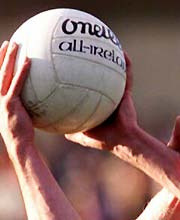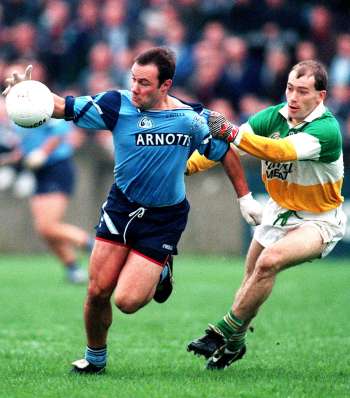|
Like hurling, Gaelic football is one of Ireland’s oldest sports. Although it predates both sports, it is often
described as a mixture of soccer and rugby (All Around Football). Much like many Irish games, Gaelic football is violent
and has considerable reference in early Irish literature as being a brutal game. Although it has evolved throughout time,
Gaelic football remains very close to its roots.

|
| The ball, made by the Irish company O'Neill's, is being used for play in a Gaelic Football match. |
Traditional Gaelic Football
Gaelic Football was first established in Ireland as the Irish version of football/soccer, an offshoot of Britain's mêlée.
At its onset, the sport remained unorganized and was officially banned from play by the Sunday Observance Act of 1695, which
imposed fines on those caught playing sports. However, it proved difficult, if not impossible, to enforce the act and the
earliest inter-county match in Ireland was officially recorded in 1712 (Gaelic Football). By the early 19th century, various
forms of football were being played throughout Ireland and the sport remained largely unorganized. It was not until 1884
that Gaelic Football was formally arranged into an organized playing code by the Gaelic Athletic Association (GAA). Since
that time, Gaelic football has dominated the Irish landscape, contesting soccer as the most popular sport nearly every year.

How Gaelic Football is Played
The dimensions of the Gaelic Football field are the same as those that play host to hurling competitions. The field's
dimensions are approximately 137m long and 82m wide with goalposts located on each side. The goalposts are the same size as
on a rugby field, but the crossbar rests slightly lower. Much like hurling, each team is comprised of 15 players but are
allowed a maximum of five substitutions a game (All About Football).
The ball used in Gaelic Football is round and slightly smaller than a regulation soccer ball. Unlike hurling, players
carry the ball in their hands. However, much like hurling, a single player may not take more than four steps with the ball
in his possession. Once he has done so, the player may bounce the ball back into the hand or pass the ball to a teammate,
but he may not bounce it twice in a row. To score, the ball may be put over the crossbar by foot or hand for one point, or
under it and into the net for a goal, worth a total of three points (All About Football).
Cultural Importance
Gaelic Football, like hurling, is a national pastime for the people of Ireland. It is widely popular throughout all of
Ireland and is another product of the sports revival brought upon by the establishment of the Gaelic Athletic Association.
Although it is mainly played in Ireland, the sport has spread to various parts of the United Kingdom and is a staple of Irelands
sports culture. It can be played by men and women throughout Ireland today.
REFERENCES
All About Football. Gaelic Athletic Association (GAA). GAA. 10 Nov. 2006 http://www.gaa.ie/page/all_about_football.html
Gaelic football. Encyclopædia Britannica. 2007. Encyclopædia Britannica Online. 30 Jan. 2007 http://www.britannica.com/eb/article-9035789
Gaelic Athletic Association (GAA). GAA. 2006. 10 Nov. 2006 http://www.gaa.ie/
|

